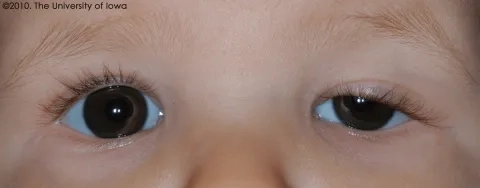Congenital Ptosis: Ptosis in Early Childhood
What is ptosis?

Ptosis refers to the drooping of the upper eyelid and when discovered to be present at birth or within the first year of age, it is referred to as congenital ptosis. Ptosis happens when there is poor development of the muscle (levator palpebrae superioris) that lifts the upper eyelid to open the eye properly1. Though rarely, ptosis can also be due to genetic2 or neurological dysfunction reasons as well3.
Signs and symptoms
One of the most obvious signs of ptosis will be drooping of either one or both eyelids1. The lowering of the upper eyelid can either be partially or fully obstructing the child’s vision. Hence, this may cause the child to either tilt the head backwards or raise their eyebrows in order to see under the lid4. The child may even need to physically lift their eyelids with their fingers in extreme cases2.
Ptosis may be associated with astigmatism, anisometropia (unequal refractive error), strabismus (squint) or amblyopia (lazy eye). The abnormal resting position of the eyelid on the cornea may cause the child to see blurry images which can result in astigmatism4 and may potentially develop into other refractive errors such as anisometropia and strabismus5. Hence, all of these conditions become a risk factor for amblyopia.
Treatment
Most ophthalmologists will recommend surgery to treat ptosis in children. However, if time permits and the young child is not at risk of deprivation amblyopia, some surgeons may wait till he/she is older in age. This will help to permit better patient cooperation and with normal growth and facial maturation, it can actually aid in more accurate pre-operative measurements5.
Ptosis surgery is done by tightening the levator muscles to elevate the eyelid4. It will allow the child to have an improvement in vision and achieve symmetry with the other upper eyelid for better cosmetic appearance. The goal is to have a reasonable symmetry of both eyelids and a full field of vision for the child to avoid developing amblyopia.
References:
- Upper Eyelid Drooping (Ptosis). Singapore General Hospital website. https://www.sgh.com.sg/patient-care/conditions-treatments/upper-eyelid-drooping/
- Droopy Eyelids/Ptosis. Eagle Eye Centre website. https://www.eagleeyecentre.com.sg/service/droopy-lids-ptosis/
- Drooping Lids. All About Vision website. https://www.allaboutvision.com/conditions/droopinglids.htm
- What is Ptosis. American Academy of Ophthalmology website. https://www.aao.org/eye-health/diseases/what-is-ptosis
- Zelinsky K, Levine MR. Evaluation and management of congenital ptosis. Ocular Surgery News U.S Edition. June 15, 2006.
- Ptosis. American Association for Pediatric Ophthalmology and Strabismus website. https://aapos.org/glossary/ptosis
- Ptosis - infants and children. Medline Plus website. https://medlineplus.gov/ency/article/003035.htm
- Congenital Ptosis. University of Iowa Healthcare - Ophthalmology and Visual Sciences website. hhttps://webeye.ophth.uiowa.edu/eyeforum/cases/114-congenital-ptosis.htm
Recent Blog Posts
- 19 Oct 2022
- 19 Oct 2022
- 19 Oct 2022
- 19 Oct 2022
- 19 Oct 2022
